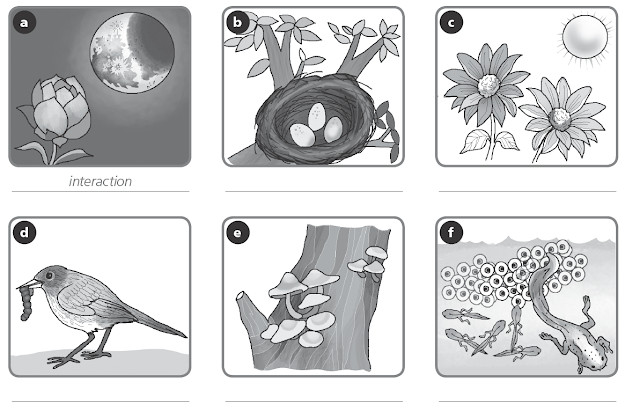VITAL FUNCTIONS
All
living things carry out these vital functions:
nutrition, interaction and reproduction
Nutrition
All
living things obtain nutrients to grow.
Animals
can be carnivores, omnivores or herbivores.
Interaction
All
living things interact with the environment around them.
They react to changes (stimuli - response).
They react to changes (stimuli - response).
For example, some living things communicate, move, etc.
Reproduction
All
living things can reproduce and create new organisms similar to them.
Reproduction can be sexual or asexual.
ACTIVITIES
- Study the information about the vital functions
-
Draw an example for each vital function in your notebook.
1. Classify:
a rock – a spider – a tree – water
– a car - the Moon – mushrooms - a robot
Living
things
|
Non-living
things
|
2. Complete the sentences with the vital functions: REPRODUTION, INTERACTION and NUTRITION.
a) Taking in food to obtain energy is called ___________________ .
b) ___________________ means producing new lives.
c) Responding to changes in the environment is called ___________________ .
d) Producing seeds, eggs or young are examples of sexual ___________________.
e) Running, fighting or communicating are examples of ___________________ .
3. Read and write NUTRITION, REPRODUCTION or INTERACTION.
a) Humans give birth to living babies. ______________________
b) A sheep needs grass and water to grow. ______________________
c) A deer sees a wolf and runs away. ______________________
d) Fungi feed on dead organisms. ______________________
4. What are the two types of reproduction? Explain and write an example for each.
5. How do animals interact with their environment? How do plants interact with their environment? Write examples.
6. What is the difference between a plastic plant and a real plant? Write three reasons.
7. Label the life processes.
8. Watch this video to learn more about the VITAL FUNCTIONS.















No hay comentarios:
Publicar un comentario